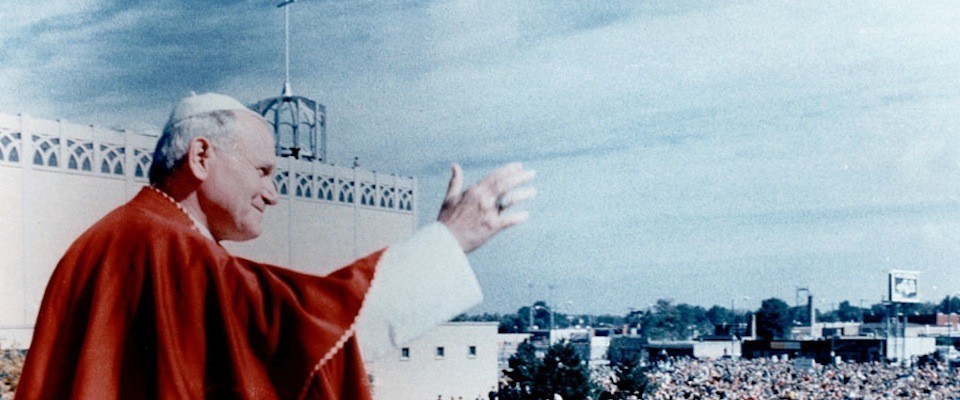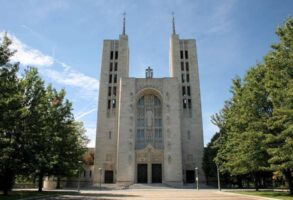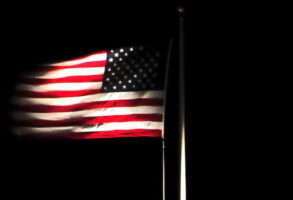
Published July 9, 2020
First Things - August 2020 issue
This essay is an adaption of Mr. Weigel’s nineteenth annual William E. Simon Lecture, delivered on March 10 in Washington, D.C., and draws on material from his Foreword to Teachings for an Unbelieving World: Newly Discovered Reflections on Paul’s Sermon at the Areopagus, by John Paul II.
On May 18, 1920, a third child and second son was born to a retired Polish army officer, Captain Karol Wojtyła, and his wife, Emilia, in Wadowice, a provincial town some fifty kilometers west of Kraków. At his baptism on June 20, the child was named for his father. To what would have been the stunned surprise of those present that day, the child grew up to be the emblematic figure of the second half of the twentieth century—as Henry Kissinger put it a few minutes after the death of Pope John Paul II on April 2, 2005. But perhaps not the stunned surprise of everyone: When the little boy’s mother pushed him in a pram through the streets of Wadowice, she would sometimes say to her neighbors, “My Lolek will be a great man someday.”
In characterizing John Paul’s greatness, Kissinger likely had in mind the Polish pope’s pivotal role in the collapse of European communism. That was no mean accomplishment. Yet John Paul’s enduring greatness may owe still more to his analysis of the human condition in late modernity and postmodernity. His insights arose from his faith, which gave him a remarkable capacity to see the world through a biblical lens; from his intellectual life, through which he understood what he had seen; and from his pastoral experience, which helped him grasp the effects of what he saw and heard in people’s lives. The salience of his analysis has increased over time. In the third decade of the twenty-first century, John Paul’s reading of the signs of the times remains a template for understanding our civilization’s distempers and rebuilding its moral-cultural foundations.
Some seeds of John Paul’s analysis of the late-modern and postmodern West can be found in a series of catechetical meditations in which then-Archbishop Karol Wojtyła, writing in the mid-1960s, pondered St. Paul’s encounter with the bien-pensants of first-century Athens on the Areopagus, as described in Acts 17:16–34. The encounter held a special place in Wojtyła’s religious imagination, for it struck him as an apt metaphor for the Church’s situation in post-Christian Europe and throughout the postmodern West. The Apostle to the Gentiles had introduced the Athenians to the “unknown God”—the one, true God—through an appeal to their experience. Wojtyła’s pastoral work in creating zones of freedom in communist-dominated Poland convinced him that the Church of the late-twentieth century and the third millennium likewise had to meet men and women where it found them, in all their confusions and strivings. Like St. Paul on the Areopagus, the Church had to work from the material at hand (the semina verbi) in trying to open hearts and minds to the liberating truth of the gospel.
St. Paul’s efforts on the Areopagus met with resistance and little immediate success. That hard fact may also help explain the vignette’s attraction for Wojtyła, who likely foresaw that great effort would be necessary, over many years, to reconvert a post-Christian West to the truths of biblical religion. As in Athens, so today, the inculturation of the gospel in smugly self-satisfied societies and cultures is not easy.
Wojtyła’s Athenian meditations preview several themes he would develop in his papal magisterium. Nine of these themes merit special attention in the year of his centenary.
What is “the West”? At the outset of his Athenian catecheses, Wojtyła asserts that the deepest taproots of the civilizational project we call “the West” are found in Jerusalem, Athens, and their interaction. Paul, the scholar-Pharisee who was familiar with trends in Greek philosophy, tried to build a conceptual bridge between the two cities and experiences. After centuries of intellectual work, a sturdy span was built, and across it walked those who gave Christianity the Nicene Creed and the dogmatic definitions of ecumenical councils such as Ephesus, Chalcedon, and Constantinople III. The intellectual synthesis of Jerusalem and Athens was not only important for Christianity, however; it was just as critical in shaping Western civilization.
Jerusalem taught the West that history is neither cyclical nor random, but linear and purposeful. History is going somewhere; so is humanity. The foundational image of that purposefulness and direction is Israel’s exodus from Egyptian bondage. Athens, for its part, taught the West that there are truths built into the world and us; that we can know those truths with a measure of certainty, through the arts of reason; and that knowing those truths, we come to understand our moral obligations and what makes for human flourishing.
Athens—the arts of reason—gave the Church, born in Jerusalem, the conceptual tools to turn its basic kerygmatic proclamation (“Jesus is Lord”) into creed and doctrine. And over the centuries, Athens often helped purify Christianity of heresy and superstition. By the same token, Jerusalem challenged, and continues to challenge, Athens to raise its sights, to stretch its imagination, to be alert for signals of transcendence in the world it analyzes through reason.
This civilization-shaping interaction found one of its taproots in Paul’s experience on the Areopagus. Little wonder, then, that a philosopher-bishop with a deep appreciation for Judaism would find in that apostolic experience a rich lode of material for reflection on the Western civilizational project and its contemporary challenges.
Humanity is theotropic. Throughout his pontificate, Wojtyła lifted up a truth essential to understanding the discontents of the secular West: The human spirit has an innate yearning for the divine and a hard-wired instinct for worship such that, if true objects of belief and worship are not found, false objects will be. As Wojtyła noted in reflecting on St. Paul’s encounter with muddled Athenian religiosity, human beings thirst for answers to the great questions of life, including the question of why there is anything at all, the question of what purpose life has, and the question of what destiny awaits each of us. Those are philosophical questions, and in his 1998 encyclical Fides et Ratio, John Paul II would challenge philosophy to recover its nerve, to stop wasting its energies on thinking-about-thinking-about-thinking, and take up the Big Questions again.
For Wojtyła, of course, the Big Questions were also religious questions. The search for answers can lead to false gods or the true God, but it will lead somewhere. In the agony of the twentieth century, which he knew from his experiences under Nazism and communism, Wojtyła saw the lethal results of worshipping false gods. Surveying the European cultural scene in the years after the Second Vatican Council, he sensed how contempt for biblical religion had led to nihilism and a diminishment of the human spirit. And like St. Paul, he wanted to turn humanity’s religious instinct toward the true God who alone is worthy of worship—the God who, being worshipped, enlarges rather than diminishes humanity.
In order to do that, Christianity had to clarify who this God is.
God is not a rival. Wojtyła’s interest in phenomenology as a philosophical method is well-known. Yet while he appreciated phenomenology’s determination to liberate philosophy from subjectivism and reconnect it to “the things themselves,” his philosophical work was grounded in the realism of Aristotle and Thomas Aquinas, which expressed what Athens had taught the West: There is something properly called the truth, and we can know it. The Thomistic dimension of this philosophical foundation is apparent when, in the third Athenian meditation, Wojtyła reminds his readers that the God of the Bible is not some super-Being in competition with the beings of this world (the mistake made by the atheistic humanists of the nineteenth century and replicated by the New Atheists of today). Rather, God is Being itself. The God who identified himself to Moses and Israel as “i am who am” (Exod. 3:14) is the philosophers’ ipsum esse subsistens: that-which-makes-all-other-being-possible. And because this God is not in competition with “other beings,” we can know God as what Wojtyła calls “the inner mystery of every creature” and especially of the human person—as the one in whom, as St. Paul put it to the Athenian Stoics and Epicureans, “we live and move and have our being.”
Here, Wojtyła believed, was an antidote to modernity’s dumbing down of the human person. On the Areopagus, Paul subtly challenged the Athenians to think of themselves as grander than they had imagined, by encountering the “unknown God” who makes himself known in history and enters history to lead humanity to its true destiny. This Pauline conviction would be at the center of John Paul’s papal magisterium for more than a quarter-century. In numerous variations on one majestic theme, he would tell the denizens of the late modern and postmodern world, “You are far more than a bundle of twitching desires. Permit me—and the biblical tradition—to remind you that the grandeur of the human person lies in that creativity which is struck from the fire of the Creator himself.”
On the Areopagus of the postmodern world, Christianity must raise the sights and aspirations of a humanity accustomed to looking down. That, Wojtyła understood, requires a fresh consideration of the meaning of freedom.
Choice” is not everything. Athenians (at least the minority who were freemen) prided themselves on their freedom to choose, to be self-governing. That pride is grotesquely distorted in those influential sectors of the contemporary West where assertiveness is the index of maturity and “choice” trumps all political argument. In his meditations, Wojtyła briefly sketched a theme that would become prominent in the second half of his pontificate: Our choosing, if it is to be truly human, must have recourse to what reason can grasp as the true and the good. Willfulness is childish; a mature freedom seeks the truth freely, adheres to it freely because it leads us to the good, and does so out of moral habit. Freedom and responsibility, Wojtyła insists, are intimately linked, and a responsible exercise of the will is ordered by reason to truth and goodness.
As he would teach in the 1991 encyclical Centesimus Annus, this nobler idea of freedom is not only critical for individuals, our moral lives, and our relationships; it is just as important for the free society. A democracy in which “choice,” understood as willfulness, trumps every other claim cannot survive. For it will sooner or later become a democracy at war with itself and its commitments, including its commitment to the principle that innocent human life deserves the protection of the law. In the 1995 encyclical Evangelium Vitae, John Paul II accordingly taught that the life issues are social justice issues.
Jesus Christ is the answer to the question that is every human life. In his Athenian catecheses, and particularly in his meditations on the meaning of the Incarnation, the Resurrection, and redemption, Wojtyła displayed the radical Christocentricity that would characterize his papal magisterium. Paul’s proclamation of the Resurrection of Jesus quickly became a sign of contradiction to many of his listeners, some of whom could imagine the immortality of the soul but none of whom could grasp what a resurrected body could possibly be or mean. Yet Paul insisted, and John Paul II underscored throughout his pontificate, that the Resurrection is the sine qua non of the entire Christian experience and proposal. No encounter with the Risen One, no Christianity—period. Meeting the Risen Lord personally (as St. Paul did) or in the act of faith and in the sacraments (as Christians have done for two millennia) changes everything. It changes especially how we think about human destiny, which becomes not just the avoidance of oblivion in some disembodied state of consciousness but the glorification of the human condition in a state of being that is radically different, yet manifestly human.
The Second Vatican Council’s most concise expression of this Easter faith comes in paragraph 22 of Gaudium et Spes, the Pastoral Constitution on the Church in the Modern World. There, the Council fathers wrote a powerful testament to Christian humanism (in words that may well have been crafted by Wojtyła): “It is only in the mystery of the Word made flesh that the mystery of man truly becomes clear. . . . Christ the Lord, Christ the new Adam, in the very revelation of the mystery of the Father and of his love, fully reveals man to himself and brings to light his most high calling.” As Christ, the incarnate Son of God and risen Lord, reveals the face of the merciful Father, he simultaneously reveals the full truth about us to us. Convinced that a “pulverization” of the human person was at the root of late modernity’s crisis of crises, John Paul, in Pauline fashion, proposed a revitalized, Christocentric humanism throughout his pontificate.
Salvation is fundamentally a matter of love. Wojtyła remarks that the “unknown God,” who revealed himself to Israel and is definitively encountered in Jesus the Lord, wishes to save that which he has created, which means redeeming the world from its incompleteness and folly.
Redemption requires judgment, for there is much that must be set right. Yet in the God proclaimed by Paul, Wojtyła noted, justice is reconciled with love. The “supreme witness” of this reconciliation was the unbreakable bond between the Cross and the Resurrection. By raising his obedient, suffering servant Jesus from the dead to a new realm of life, God demonstrated that divine love is the most powerful thing imaginable, more powerful even than death. The God proclaimed by Paul is thus more than an unmoved mover, a first cause—even more than a creator. The God of Paul is the redeemer, “the One who has overcome everything,” as Wojtyła’s meditations put it, because this God is love itself.
That was the conviction on which Karol Wojtyła staked his life. The dissident Marxist Milovan Djilas once said that John Paul II was the only person he had ever met who was entirely without fear. The root of that fearlessness was John Paul’s unshakeable belief in the cruciform, redemptive power of divine love. At the same time, Wojtyła’s defining conviction that the God who is love had entered history as redeemer was the source of his extraordinary capacity to enter empathetically into others’ lives—for everyone Wojtyła met was a someone for whom divine love had entered the world as redeeming and salvific, in the person of the incarnate Son of God.
Love is self-gift. John Paul II frequently paired citations of Gaudium et Spes paragraphs 22 and 24: “Man can fully discover his true self only in a sincere giving of himself.” Jesus Christ reveals the truth about us, and an essential part of that truth, demonstrated by Christ’s passion, death, and Resurrection, is that self-gift, not self-assertion, is the road to human flourishing and beatitude.
This is, obviously, a countercultural claim in the twenty-first-century West, where self-assertion underwrites a host of social movements, some of which argue from self-assertion to the infinite plasticity of the human condition. As a Christian theologian and pastor, Wojtyła taught that self-gift, modeled in Christ, is at the center of Christian ethics. As a philosopher, Wojtyła argued that there is a “Law of the Gift,” a law of self-giving, built into the human person, and that this law could be discovered through a disciplined reflection on the structure of moral agency. As he put it in a 1974 conference paper, “In the experience of self-determination the human person stands revealed before us as a distinctive structure of self-possession and self-governance . . . [and] it is precisely when one becomes a gift for others that one most fully becomes oneself.”
Once again faith and reason, Jerusalem and Athens, work together in a Pauline synthesis to lift the human spirit from the loneliness imposed by self-absorption and willfulness, raising human aspirations beyond immediate gratification.
From Vatican II to the “New Evangelization.” Wojtyła’s Athenian meditations quote extensively from the documents of the Second Vatican Council, which, like the Second World War, was a decisive experience for him.
Vatican II was many things to Wojtyła. It was a second graduate-level education in theology, an encounter with new thinkers and ideas. It was a bracing first experience of the Christians of the developing world. The spontaneity and clarity of faith of the African bishops at the Council left a deep impression on Wojtyła, and senior African churchmen, often first- or second-generation Christians, were to play prominent roles in his pontificate. Perhaps above all, Wojtyła lived Vatican II as what Pope John XXIII intended it to be: a new experience of Pentecost, from which the Church would enter its third millennium with revitalized evangelical zeal and a new passion for mission.
As pope, Wojtyła put evangelism at the center of his teaching. In the 1990 encyclical Redemptoris Missio he used the image of the Areopagus to illustrate the sectors of late-modern and postmodern society in which the laity were particularly fit to be agents of evangelization: science and the media; the environmental and women’s movements; the worlds of politics, culture, and economics. All of these awaited disciples willing to propose the true God as the answer to the twenty-first century’s false gods. And it was John Paul II’s purpose to call everyone in the Church to be a missionary disciple. So in Novo Millennio Ineunte, his apostolic letter closing the Great Jubilee of 2000, John Paul adopted an image from the fifth chapter of Luke’s Gospel and summoned the Church to “put out into the deep” (Luke 5:5)—to leave the shallow, brackish waters of institutional maintenance in order to make a great catch, not of fish, but of souls.
A public Church. As John Paul II envisioned it, the Church of the twenty-first century would be neither established nor partisan. As he wrote in Redemptoris Missio, “The Church proposes; she imposes nothing.” The Church asks, and if necessary demands (as under communism), to make its evangelical proposal in public; and it claims the right, as a civil society institution, to be a vigorous partner in the public debate. But the Church does not seek legal establishment, nor does it act as chaplain to any political party. Partisanship jeopardizes the independence of the Church; more importantly, it reduces the gospel to a political program. Nor would the twenty-first-century Church be a privatized Church, withdrawn from the public square of its own volition, or by the application of coercive state power, or both.
European Catholicism had long been accustomed to ecclesiastical establishment. Those days, John Paul knew, were over. The alternative to ecclesiastical establishment was neither a privatized nor a ghettoized nor a partisan Church, but a public Church—what John Paul called in Redemptoris Missio a proposing Church. This proposing Church would work in public primarily through the free associations of civil society. The proposing, public Catholicism of the twenty-first century would make arguments; it would not seek to craft policies, though its arguments would underscore that some policies were more compatible than others with freedom lived in solidarity and for the common good. The Church sketched by John Paul’s social magisterium would work at a deeper level of public life: the level of cultural self-understanding. It would be guardian and teacher of the truths that make it possible to live freedom well.
This idea of a public Church also discloses something important about the free society in the twenty-first century. The openness of the free society cannot mean a public space from which religious conviction is excluded as a source of moral and political insight. John Paul believed that the West must rid itself of the idea that democracy, freedom, and openness require a “laïcité” that creates a religiously naked public square. Laïcité is itself undemocratic, for it denies to many citizens the right to bring the deepest sources of their moral convictions into public life.
The post-Christian West is increasingly the post-rational West, as demonstrated by dysfunctional politics and the West’s failure to mount a culturally transmitted and politically resonant defense of democracy and the free society on anything other than utilitarian grounds. John Paul II saw this coming. The public Church he envisioned—neither established nor partisan nor ghettoized—could play an important role in revitalizing the convictions about reason and truth that were cornerstones in the cultural architecture of the West. In order to do this, he understood, the Church must purify herself so that the truths she proposes are seen to be the truths she lives.
Karol Wojtyła’s meditations on St. Paul’s experience on the Areopagus unveil aspects of his greatness that would be overlooked if historians focused too narrowly on the likelihood that he was the most publicly consequential pope—the pope with the greatest impact on the history of his times—since the High Middle Ages. During his centenary year, millions of men and women now living in free societies will give thanks that Pope John Paul II inspired a revolution of conscience in the 1980s, which in turn shaped the Revolution of 1989 and the largely nonviolent collapse of European communism. But the greatness of the man many call “St. John Paul the Great” was not limited to his impact on the world of affairs, nor was it simply a manifestation of striking personal gifts and qualities. For John Paul was, above all, a radically converted Christian disciple and a dedicated Christian pastor, who believed that his discipleship and pastoral responsibilities demanded a careful analysis of the signs of the times. His analysis of those signs remains as salient today as it was when Karol Wojtyła wrote his Athenian meditations, or when John Paul II looked into the post–Cold War future and identified the many challenges facing Western democracies whose moral and cultural foundations were eroding, with inevitable effects on public life and politics.
Neither the world nor the Catholic Church has adequately learned from that analysis. Both would do well to try.
George Weigel is Distinguished Senior Fellow of the Ethics and Public Policy Center.











